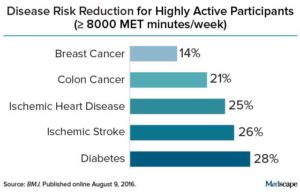 Surprised...is how I felt after reading this study. According to the study, activity levels and exercise in mid-life are not linked to cognitive fitness and dementia later on in life. Instead, higher levels of physical activity and exercise has a beneficial effect on the brain in the short term (e.g., within 2 years or so). This finding of no long-term benefits, but only short-term benefits to the brain from exercise, is contrary to some other (cross-sectional) studies, but is supported by another recent study ("no evidence of a neuroprotective effect of physical activity").
Surprised...is how I felt after reading this study. According to the study, activity levels and exercise in mid-life are not linked to cognitive fitness and dementia later on in life. Instead, higher levels of physical activity and exercise has a beneficial effect on the brain in the short term (e.g., within 2 years or so). This finding of no long-term benefits, but only short-term benefits to the brain from exercise, is contrary to some other (cross-sectional) studies, but is supported by another recent study ("no evidence of a neuroprotective effect of physical activity").
The beauty of this study is that it followed 646 people for 30 years (from a median age of 46 years in 1978 and 77 years in 2008). The negative is that according to this study, physical exercise in mid-life does not seem to delay or prevent the onset of dementia and Alzheimer's later on in life. Eh... From Medical Xpress:
Physical activity in midlife not linked to cognitive fitness in later years, long-term study shows
A study led by Johns Hopkins Bloomberg School of Public Health researchers that tracked activity levels of 646 adults over 30 years found that, contrary to previous research, exercise in mid-life was not linked to cognitive fitness in later years. The finding suggests that physical activity may not help maintain cognitive function, or help avoid or delay the onset of the debilitating conditions like dementia and Alzheimer's.
The study, which appears online in the Journal of Alzheimer's Disease, did find that activity levels among study participants in the later years were associated with high cognitive function two years later. This supports earlier research findings that exercise may help to maintain cognitive fitness in the short term.
There is no known treatment or cure for Alzheimer's or dementia, syndromes that involves declining memory, confusion and eventually limited ability to perform daily tasks. To date, there are no preventive measures, such as physical exercise, brain games or a diet regimen, that have been proven to help delay or altogether prevent its onset. The researchers undertook the study because of a growing consensus that physical activity levels helps prevent Alzheimer's, however much of the evidence for this thinking is based on cross-sectional studies that compare responses from one group of participants with another at a given point in time or within a very short duration, typically several years..... That's where longitudinal studies, which look at the same group of participants over a long time, are more helpful.
The researchers used data from the Johns Hopkins Precursors study.... The researchers used responses from 1978 through 2008 from 646 participants (598 men, 48 women) to calculate so-called metabolic equivalents, which quantify physical activity levels. Participants were also asked whether they regularly exercise to a sweat. The team administered cognitive tests in 2008, and, using participants' medical records, scored for dementia through 2011. The researchers identified 28, or 4.5 percent of the cohort, to have Alzheimer's.
No physical activity measure in mid-life was associated with late-life cognitive fitness or onset of dementia. The study confirmed findings of other cross-sectional studies, that higher levels of physical activity and exercise measured close in time to the cognitive testing were associated with better cognitive functioning. The authors also looked at whether patterns of change in physical activity levels over the life span were associated with cognitive health and found no relationships.
The idea that exercise might play a role in preventing or limiting Alzheimer's makes sense, the researchers say, because physical activity, at least in mouse models, has shown less accumulation of B-amyloid plaques, which are thought to play a role in dementia, including Alzheimer's. In addition, physical activity improves blood flow to the brain, which is linked to better cognitive performance. This may explain why studies find that exercise may contribute to cognitive fitness in the short term.

 Again, another study showing the importance of lifestyle factors in the development of protein buildups in the brain that are associated with the onset of Alzheimer's disease. Specifically, the study found that each one of several lifestyle factors—a healthy body mass index, physical activity and a Mediterranean diet, were linked to lower levels of plaques and tangles on brain scans in people who already had mild memory changes, (but not dementia). Other posts discussing Mediterranean diet and brain health (brain volume, etc.) are
Again, another study showing the importance of lifestyle factors in the development of protein buildups in the brain that are associated with the onset of Alzheimer's disease. Specifically, the study found that each one of several lifestyle factors—a healthy body mass index, physical activity and a Mediterranean diet, were linked to lower levels of plaques and tangles on brain scans in people who already had mild memory changes, (but not dementia). Other posts discussing Mediterranean diet and brain health (brain volume, etc.) are  Credit: Medscape
Credit: Medscape